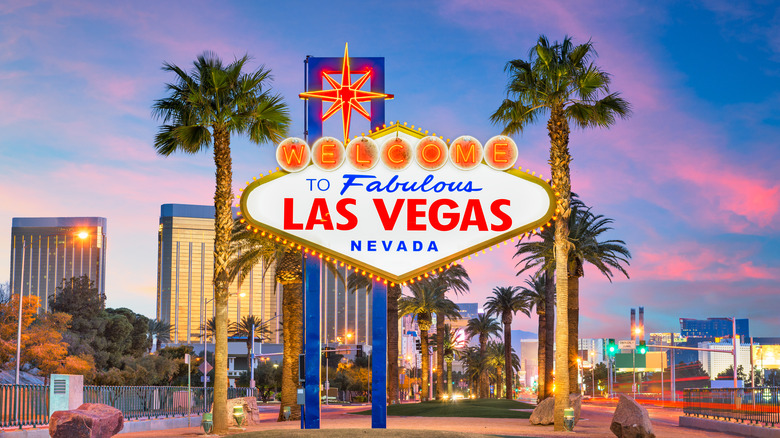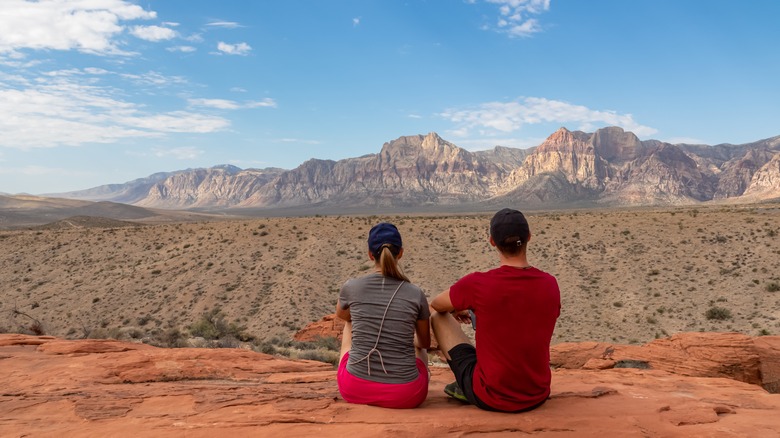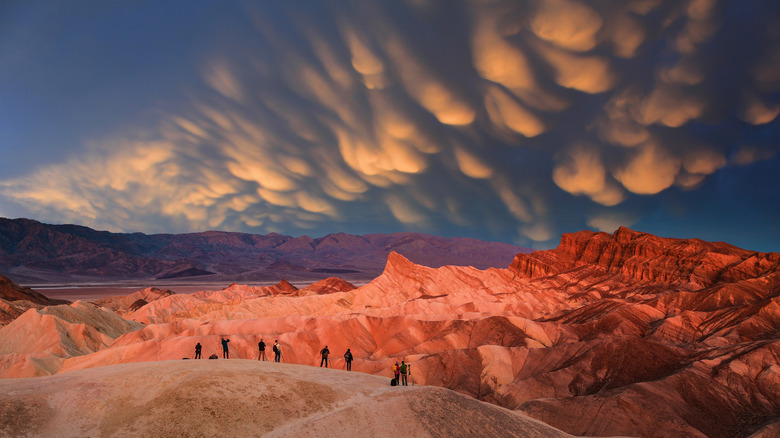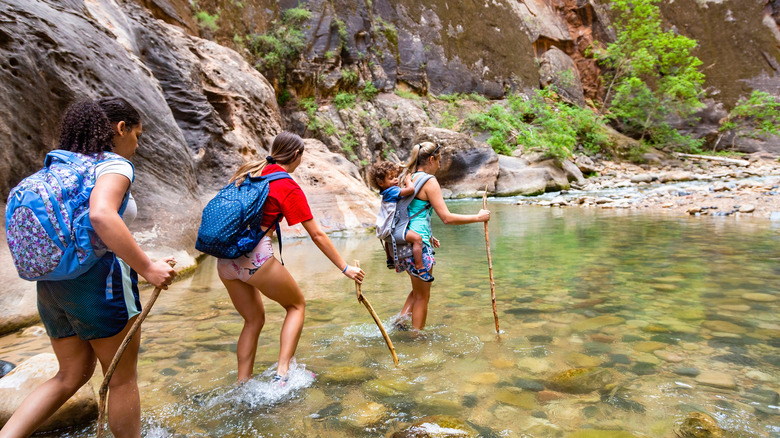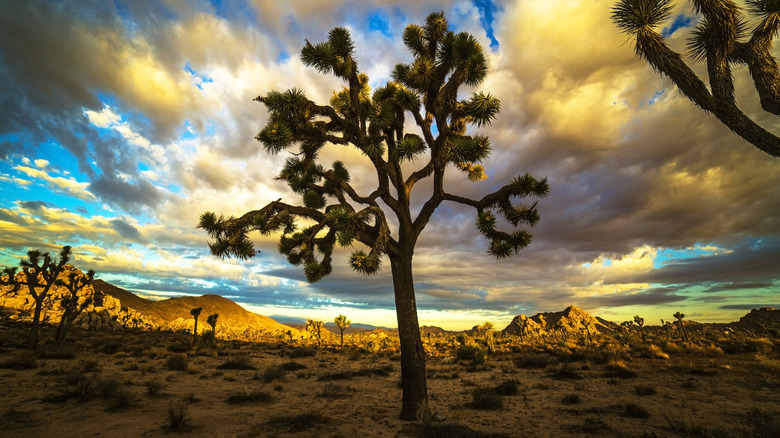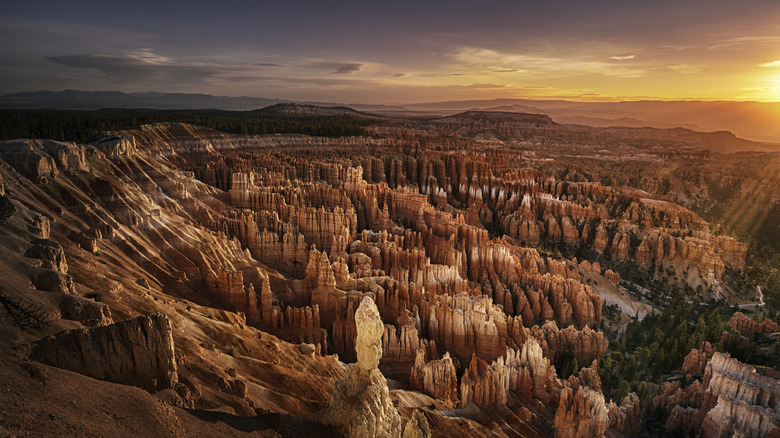The Best National Parks That Are Within Close Driving Distance Of Las Vegas
Las Vegas, Nevada, has long been a destination for anyone who loves a good time. From big name performer residencies over the years by the likes of Cher, Celine Dion, and Elton John to the elaborate themed hotels with luxurious pools, restaurants, and casinos along the famed Las Vegas Strip, it's a world-renowned playground with a lot to take in. All in all, Vegas is pretty much the opposite of a national park.
That's not to say that one is better than the other, but if you want to escape the glitz and glam or plan a trip that encompasses both the wilds of the Vegas Strip and of the natural world, there are some beautifully wild and rugged national parks and national recreation areas close by. Admittedly, when it comes to driving distances in the American West, close by is a relative phrase. However, all five of these federally protected areas are within a 4-hour drive from Las Vegas, barring any road construction or other delays, and they're all veritable wilderness playgrounds for outdoor enthusiasts. So on your next trip to Vegas, you might want to think about packing your favorite hiking gear, too.
Red Rock Canyon National Conservation Area
It only takes about a half-hour to drive from the Las Vegas Strip west to the Red Rock Canyon National Conservation Area in the Mojave Desert, but you'll feel worlds away amongst the red sandstone formations. While Red Rock Canyon is managed by the Bureau of Land Management and is not technically a national park, in 1990, the U.S. Congress designated it a National Conversation Area, which officially recognized it as a unique and valuable landscape and protected the area's natural and cultural resources while keeping it open for outdoor recreation and public access.
If you don't have a lot of time, you could stay in your car and enjoy the stunning views on the 13-mile, one-way Scenic Drive through the conservation area, starting near the Visitor Center at the park's entrance. Plan ahead — all cars must have a reservation to drive the road between October 1 and May 31. If you have the time, stop along the Scenic Drive and go for a hike or a bike ride — there are dozens of trails, including easy, family-friendly options as well as multi-hour challenges. One easy hike, which also showcases the area's deep history, is the Petroglyph Wall Trail off Willow Springs Trail. You can see paintings and carvings made hundreds of years ago. Red Rock Canyon is also a well-known rock climbing destination with thousands of routes up the sandstone walls with something for every type of climber.
Death Valley National Park
Near the border of California and Arizona, Death Valley National Park is about a 2-hour drive from Las Vegas. The park is all about superlatives — the National Parks Service website bills the parks as the "hottest, driest, and lowest national park." It's also America's largest national park outside of Alaska.
The landscape is a mix of badlands, salt flats, canyons, and mountains. Some can't miss spots — Badwater Basin, a massive salt flat that's 282-ft below sea level, which is North America's lowest point, and Zabriskie Point, a fantastic place to watch the sunrise. The views are well-worth the early wake-up time, and it's a quarter-mile walk from the parking lot. Then there's Artists Palette, an area accessible by the aptly named Artists Drive Scenic Loop, where the mountains look like rainbows, with unexpected blues, purples, reds, yellows, and greens.
Something to keep in mind when you visit: The heat is no joke. It can get over 120°F in summer — in the shade. While it's a desert valley with average annual rainfall of around just 2 inches, when storms do come through, they can cause dangerous flash flooding. Those factors are a big part of why it's on our list of the world's most dangerous parks, but if you take some reasonable precautions, like staying hydrated, carrying extra water in your car, and paying attention to the weather, you'll not only be safe, you'll possibly fall in love with this otherworldly park.
Zion National Park
Approximately 155 miles northeast of Las Vegas is Zion National Park — Utah's first national park (it now has five). One of its most popular and well-known hikes is The Narrows, which gets its name because it takes you through the narrowest part of Zion Canyon. You're literally walking in the riverbed of the Virgin River — that's the trail — with 1,000-feet-tall cliffs on either side. Depending on the season (and your height), that can mean water up to your calves or up to your chest at some parts. If you're planning your Vegas trip to include a side trip to Zion to hike The Narrows, water levels are generally lowest in the summer and into fall, and spring can bring flash floods so the hike may close for weeks at a time.
Angel's Landing is another legendary Zion hike. Its popularity (aka overcrowding) led the National Park Service to institute a permit requirement. It's one of those national park trails only for experienced hikers; the 5.4-mi out-and-back trail has 1,500-ft of elevation change, and the last half mile of the trail takes you along a narrow ridge where chains have been put in place to help you hold on. The reward for your hard work is 360-degree views of the canyons at the summit.
Zion is also fantastic for stargazing, too. Check out Canyon Junction Bridge, the Pa'rus Trail, and the Lava Point Overlook to see the Milky Way in all its glory.
Joshua Tree National Park
Joshua Tree National Park in southern California is a 3.5- to 4-hour drive from Las Vegas, depending on which part of the nearly 800,000-acre park you're visiting. The trees that give the park its name are found in the park's higher desert elevations, like Black Rock Canyon on the park's northwest side. It's a great spot for an easy camping retreat for both tents and RVs with easy access to water and bathrooms plus picnic tables and fire rings at each campsite. The nature center here is the trailhead for a variety of trails from the easy 1.3-mi Hi-View Nature Trail to the 6.3-mi Warren Peak summit hike.
Joshua Tree National Park may be in the desert, but if you're there at the right time, you can see some amazing wildflowers. Depending on winter rainfall, the spring blooms may be bigger and more impressive some years, but throughout the spring season, there will always be something flowering. Along with its unique flora, the park has some impressive rock formations. Hike through some of the park's most popular formations on the 1.2-mi trail to Arch Rock in the Twin Tanks section of the park and the 1.7-mi Skull Rock nature trail at the Jumbo Rocks Campground.
Another side to Joshua Tree's beauty comes out at night. It's a designated International Dark Sky Park, providing visitors with the ideal conditions to marvel at the heavens.
Bryce Canyon National Park
Bryce Canyon National Park is a 4-hour drive northeast from Las Vegas. The park's signature feature is its hoodoos — dramatic columns and spires of weathered rock. You can see them en masse at the Bryce Amphitheater, one of several naturally formed massive bowl areas of the park. Some of the park's most beautiful overlooks are of the Bryce Amphitheater, including Inspiration Point, Sunrise Point, and Sunset Point. You can drive along the park's main road or take the free shuttle to see these famous spots. Or you can hike the Rim Trail, which runs for 5.5-mi along the amphitheater. If you don't want to hike the full thing, you can use the free shuttle as a hop-on, hop-off type service to hike shorter sections of the trail. If you're with young kids in strollers or anyone with a wheelchair, the half-mile section of the Rim Trail between Sunset and Sunrise Points is paved and mostly flat.
Bryce Canyon is at a higher elevation — between 6,620 and 9,115 feet — so you can expect it to be cooler than the other national parks near Las Vegas in the summer. And like many of the parks nearby, it's also a fantastic place to take in the beauty of the night sky. Rangers lead night sky telescope programs on Fridays and Saturdays between Memorial Day and Labor Day, and the park holds an annual Astronomy Festival with a variety of sky themed activities.
